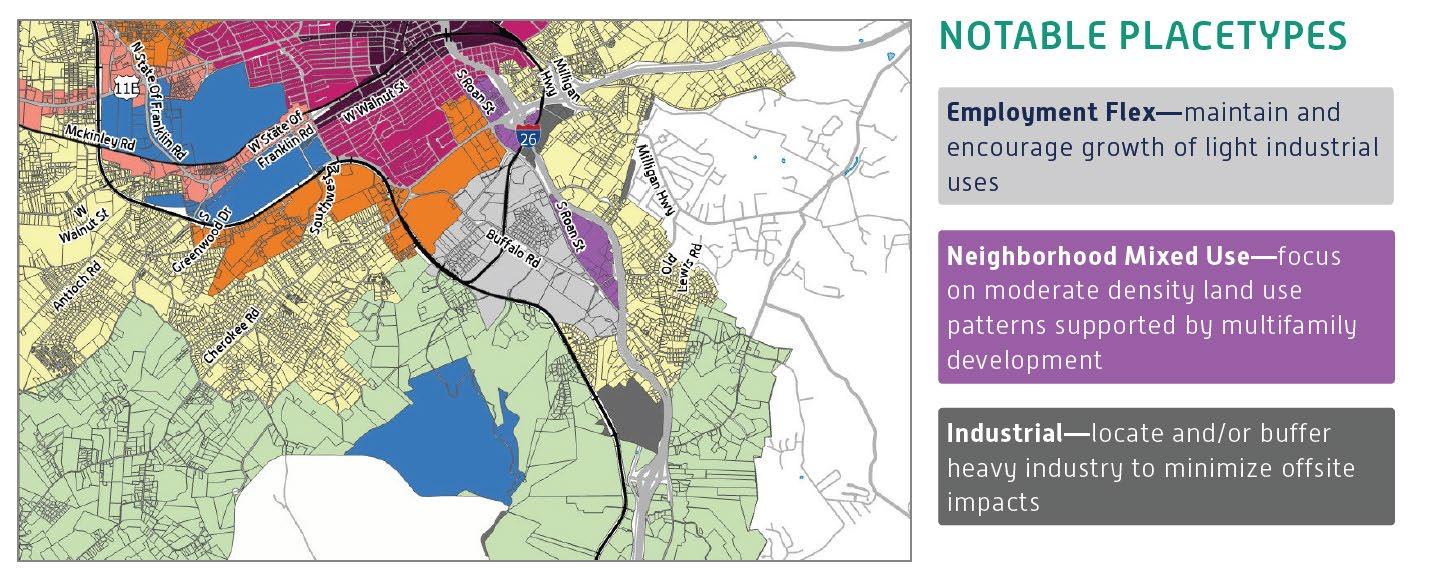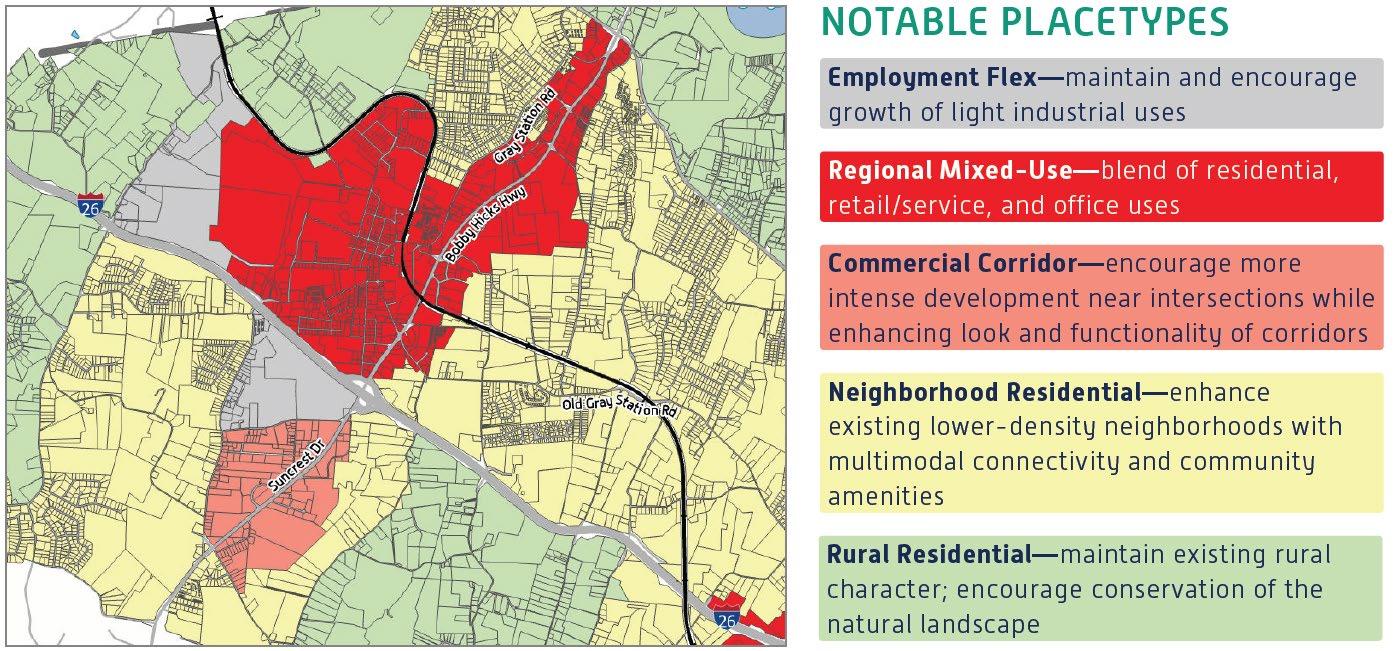Future Land Use Strategies
Public Workshop #3
December 2024
PHASE 3 ENGAGEMENT SUMMARY



Public Workshop #3
December 2024
PHASE 3 ENGAGEMENT SUMMARY


Attendees reviewed a draft of the Future Land Use Map, shared feedback using numbered comment cards, and indicated whether the map aligned with their vision for the future.

PHASE 3 ENGAGEMENT SUMMARY

25. “I love the commitment to denser mixed-use zones. This will create better human centered, livable spaces that combined with multi-modal transport will help to reduce traffic and diversify housing options.”
Participants used randomly numbered comment cards and dots where they could write the number to provide location-based feedback on the FLUM. 23 total comments were received. A sample of those comments is shown here.


64. “The Cross Road intersection needs improvement.”



13. “Need for coordination of master plans in special zones such as between ETSU, VA, parks and rec, the city, and others.”


How well does the FLUM capture what you would like to see for the future?

PHASE 3 ENGAGEMENT SUMMARY
As part of this activity, participants placed dots on various scales to answer questions about four feedback areas. Each feedback area is described by its most notable placetypes. Placetypes are the building blocks for the Future Land Use Map that describe desired land use and character.

PHASE 3 ENGAGEMENT SUMMARY

Employment Flex
Light industrial activities that do not conflict with nearby non-industrial sites
Regional Mixed-Use
Blend of residential, retail/service, and office creates these vibrant, livable areas
Commercial Corridor
Supports the commercial needs of the City and enhances the functionality of corridors
Neighborhood Residential
Lower-density neighborhoods with connections to community amenities
Rural Residential
Rural character preserved through cluster development and conservation areas

PHASE 3 ENGAGEMENT SUMMARY
Do you feel the boundary of the Regional Mixed-Use placetype is appropriately sized?
Needs to be Smaller

Needs to be Larger
How important is it to incorporate a mix of housing types into the Gray area in the future?
Not Important Very Important
How important is it for this area to include opportunities for jobs in the future?
Not Important Very Important

Unique character with diverse housing that is pedestrian-friendly and well-connected
Small-scale commercial, office, and service uses that integrate with nearby residential
Thriving downtown atmosphere that serves as a destination for locals and tourists
Unique places and uses that are likely to have their own master plan

PHASE 3 ENGAGEMENT SUMMARY
Do you feel the boundary of the Downtown Core placetype is appropriately sized?
Needs to be Smaller

Needs to be Larger
Do you feel the boundary of the Downtown Connected Placetype is appropriately sized?
Needs to be Smaller
Needs to be Larger
How important is it to improve pedestrian access between Downtown Core and Downtown Connected?
Not Important Very Important
How important is it to prioritize public open space in the Downtown Core and Downtown Connected?
Not Important Very Important

Light industrial activities that do not conflict with nearby non-industrial sites
Blend of uses to create vibrant, livable areas well-positioned for redevelopment
Industrial
Locations with the appropriate buffers for large-scale industrial activity

PHASE 3 ENGAGEMENT SUMMARY
How much change should be encouraged for the revitalization along South Roan?
No Change Significant Change

How important is it for the corridor to transition industrial land to other uses, such as commercial, housing, or mixed-use development?
Not Important Very Important
How important is it for the corridor to attract businesses and create new job opportunities?
Not Important Very Important


Neighborhood Mixed Use
Blend of uses to create vibrant, livable areas well-positioned for redevelopment
Special District
Unique places and uses that are likely to have their own master plan
Commercial Corridor
Supports the commercial needs of the City and enhances the functionality of corridors
Neighborhood Residential
Lower-density neighborhoods with connections to community amenities
How much should the corridor focus on attracting businesses and creating new job opportunities?
No Focus High Focus

Do you support growth in commercial and mixed-use land uses along Bristol Highway?
Not Supportive
Very Supportive
Attendees reviewed a sample of high-level strategies for the eight planning themes and used dots to vote for the strategies they felt were the most important.

Q-1 | Promote innovative, high-quality, and compact development that discourages urban sprawl.
Q-2 | Encourage the concept of mixed-use development to create diverse, equitable, and attractive neighborhoods.
Q-3 | Promote the expansion of commercial and industrial areas to encourage growth and development of the City’s tax base.

N-1 | Facilitate the private construction of housing supply with a focus on creating housing for a wide range of incomes.
N-2 | Maintain and improve existing neighborhoods as desirable places to live.
N-3 | Preserve, protect, and enhance exiting historic housing, including structures and sites.

P-1 | Diversify the economy and broaden the tax base.
P-2 | Improve and protect the natural and built environment as assets that attract economic development opportunities and enhance Johnson City’s quality of life.
P-3 | Enhance employment opportunities for young adults that offer higher quality jobs and a greater range of careers.
C-1 | Monitor traffic volumes, levels of service, safety, and land platting on an on-going basis to anticipate needed improvements to the local transportation system.
C-2 | Create a network of bikeways and greenways capable of supporting multiple users for transportation and recreation purposes.
C-3 | Provide a sidewalk network that supports pedestrian access to all parts of the city and meets current ADA standards.
V-1 | Create a physical setting that is comfortable, convenient, visually interesting, and secure.
V-2 | Encourage the renovation and rehabilitation of existing buildings and storefronts.
V-3 | Support shared parking to maximize parking arrangements, increase parking supply near key downtown destinations, and expand access to pedestrian networks.
H-1 | Protect priority agricultural assets as important components of Johnson City’s quality of life and economic base.
H-2 | Provide recreation facilities and programming that will meet the needs of the City’s residents.
H-3 | Improve the City of Johnson City’s Parks and Recreation system through the construction or acquisition of new facilities at appropriate locations.

S-1 | Ensure the provision and maintenance of community facilities and services necessary to meet the needs and interests of residents.
S-2 | Give priority to new developments that can be served by public utilities already in place.
S-3 | Continually strive for the greatest equity, effectiveness, and efficiency in the delivery of first responder services.

F-1 | Provide new, properly located, high-quality educational facilities that serve as community centers and support the desired land use pattern in Johnson City.
F-2 | Provide adequate school capacity for present and future enrollment; coordinate these efforts between the City and Johnson City Schools.
F-3 | Continue to provide equitable provision of educational facilities and services, while strategically locating new schools to promote infill development and discourage sprawl.
Digital Engagement Activity

PHASE 3 ENGAGEMENT SUMMARY

• Used the Social Pinpoint
• Open November 18, 2024 –January 6, 2025
• Advertised via email, city website, and social media
134 Contributions
85 Written Comments
348 Data Points
Survey Results

PHASE 3 ENGAGEMENT SUMMARY

Survey participants were asked to rank the balance of the placetypes on the Future Land Use Map (FLUM). In addition, participants ranked different elements in select geographic areas and could provide additional feedback on the draft FLUM and the placetypes.

PHASE 3 ENGAGEMENT SUMMARY
Q1: Do you think we’ve struck the right balance between residential and nonresidential placetypes shown on the draft Future Land Use Map

Participants perceive the balance between residential and non-residential placetypes on the draft Future Land Use Map as moderately appropriate with some indicating room for refinement if needed. Participants were asked to elaborate on their ranking in the next survey question.

• Participants provided supplementary comments to support their preference for the balance between residential and non-residential uses in the draft FLUM
• 26 responses (examples at right)
• Key themes included concerns for overdevelopment and preservation, desire for more mixed-use development, the need for infrastructure to support growth, housing affordability, improved connectivity, and a preference for controlled growth

Mixed use areas that run into residential should be carefully planned that the use areas do not over encompass the connected residential.

While we do need more housing availability in Johnson City, there should be more non-residential availability. Both for work and recreation.

There needs to be more high density residential to help create more affordable housing.
Gray already struggles with traffic. If you add this much more residential, we'll need a lot more intersections on Suncrest Drive.



Are there any areas on the Future Land Use Map where you believe more industrial or employment flex placetypes should be considered? If so, where and why?
• Participants shared where they wanted to see more industrial or employment flex placetypes
• 20 responses (examples at right)
• Key themes included expanded employment flex placetype between Boones Creek, Gray, and South Roan and a desire for multi-purpose development that combines work, transit, recreation, and shopping

Maximize areas in the "rural residential" types between "neighborhood residential" types. That would allow for closer worker proximity to new jobs.

Boones Creek Rd, there is lots of place for business industry that would give people more job opportunities.
More employment flex between Boones Creek and Gray to accommodate the growing population and increased housing costs in Johnson City.


I think having more flex placetypes will help give better work, transit, recreation, and shopping opportunities for residents.



Does the draft Future Land Use Map support connectivity between destinations? Where do you see opportunities for improvement?
• Participants shared where more connectivity is needed
• 19 responses (examples at right)
• Key themes include better roadway and transit connectivity across the city, denser development, and integration of commercial and residential uses

I think either increasing regional transit options or having more flex types will help with connectivity.

Suncrest Drive needs more intersections with lights to help with traffic flow, especially around rush hour. The areas surrounding downtown need to be high density residential and there needs to be more public transit


As far as connectivity goes, it all seems well to me, further densifying the core, would be ideal. Maybe creating transitoriented development too.
Feedback Area Results

PHASE 3 ENGAGEMENT SUMMARY

PHASE 3 ENGAGEMENT SUMMARY


Participants lean toward significant change to be incorporated into the revitalization of South Roan, indicating a desire for transformative efforts to address the community's needs and goals.
How important is it for the corridor to transition industrial land to other uses, such as commercial, housing, or mixed-use development?
Participants view transitioning industrial land to other uses as highly important, reflecting a strong preference for reimagining the corridor.

Participants prioritize attracting businesses and creating new job opportunities on South Roan Street, highlighting a strong desire for economic growth and enhanced employment prospects within the corridor.
Feedback Area Results

PHASE 3 ENGAGEMENT SUMMARY

PHASE 3 ENGAGEMENT SUMMARY

Q1: How do you feel the boundary of the Downtown Core placetype is appropriately sized?

Participants perceive the Downtown Core placetype boundary as moderately appropriate, suggesting an interest in possibly expanding the Downtown Core placetype.
Do you feel the boundary of the Downtown Connected placetype is appropriately sized?
Participants perceive the Downtown Connected placetype boundary as moderately appropriate, suggesting that the line between the Downtown Core and the surrounding neighborhoods may be blurring.
Q3: How important is it to improve pedestrian connections between the Downtown Core and Downtown Connected placetypes?

Participants place high importance on improving pedestrian connections between the Downtown Core and Downtown Connected placetypes, reflecting a preference for enhancing accessibility and connectivity.
Participants value prioritizing additional public open space within the Downtown Core and Downtown Connected placetypes, reflecting a preference for further enhancing recreational and community-oriented spaces.
Feedback Area Results

PHASE 3 ENGAGEMENT SUMMARY


PHASE 3 ENGAGEMENT SUMMARY

Participants expressed a moderate focus on attracting businesses and creating new job opportunities on Bristol Highway, indicating a balanced approach to development and retention of the current character along the corridor is preferred.
Participants showed moderate support for growth in commercial and mixed-use land along Bristol Highway, indicating a desire for a balanced perspective on development in the area.
Feedback Area Results

PHASE 3 ENGAGEMENT SUMMARY


3 ENGAGEMENT SUMMARY
Q1: Do you feel the boundary of regional mixed-use placetype in this area is appropriately sized?

Participants perceive the boundary of the regional mixed-use placetype as just right, with a slight tendency toward considering expansion of its size, if needed, to better support community needs.
Q2: How important is it to incorporate a mix of housing types into this area in the future?
Participants view incorporating a mix of housing types into the area as moderately important, reflecting an interest in promoting housing diversity for future development.

How important is it for this area to include opportunities for jobs in the future?
Participants consider including opportunities for jobs in this area as highly important, emphasizing a strong interest in fostering economic growth and employment opportunities in Gray.